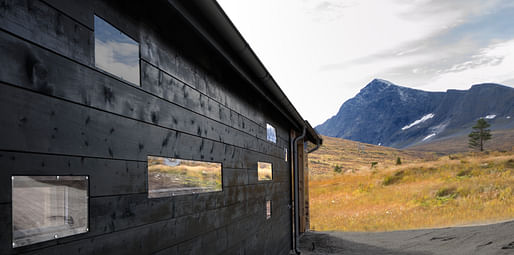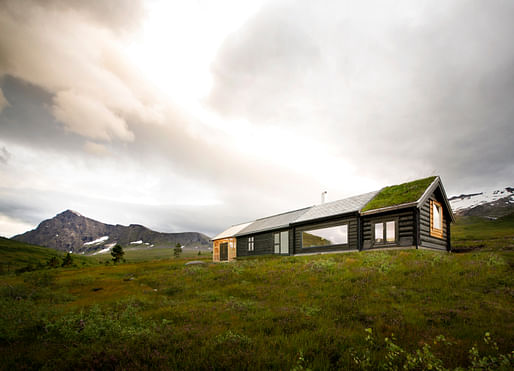
A cabin by Norwegian architectural office Rever & Drage takes a unique form as a single unit and the combination of four distinct buildings.
Called Cabin at Troll’s Peak, the roughly 1,500-square-foot structure features local craftsmanship and regional timber spread across a connecting row of different buildings. This composition recalls a traditional row farm, in which buildings with different functions and different construction techniques are arranged in a line corresponding with the dominant direction of the wind.

As detailed by the architects, the furthest north section of the cabin comprises a late medieval notching technique with large, narrowing logs. The living room is built with 19th-century notched logs, while the kitchen has slim, more modern square logs with dovetail notches. The garage is built from a local timber frame technique and clad with transparent polycarbonate.
Located in a high mountain valley in Sunndal, Norway, the cabin was designed for an active outdoor family in need of a comfortable place to change before and after hiking and skiing trips. The building is expected to transport hikers from the glassed-in garage, bathroom, and kitchen to a comfortable living room and the bedrooms.

The garage functions as a storage room, workout room, workshop, and conservatory. Here, all of the traditional wooden joints are exposed and well-lit. The living room features a barrel vault ceiling, which frames a distinct panorama window. The window’s low position emphasizes that this is a space to sit and relax.

Next to the living room are two small rooms, which can serve as either an extra bedroom or workplace. Between the two rooms lies another entrance with a gable-fronted dormer. The kitchen is described as airy and comfortable, with ample natural light through small windows that are recessed in the timber. The bathroom also includes the same type of recessed windows to allow daylight while remaining private.
Each of the cabin’s distinct units are unified by color, a deep, dark green, tar-based timber oil, and the common direction of their gabled roofs.
Along the western façade of the building, the individual characteristics of the different units are the most obvious, while the eastern façade is more uniform, and the cabin, as a whole, is more distinguished.


No Comments
Block this user
Are you sure you want to block this user and hide all related comments throughout the site?
Archinect
This is your first comment on Archinect. Your comment will be visible once approved.